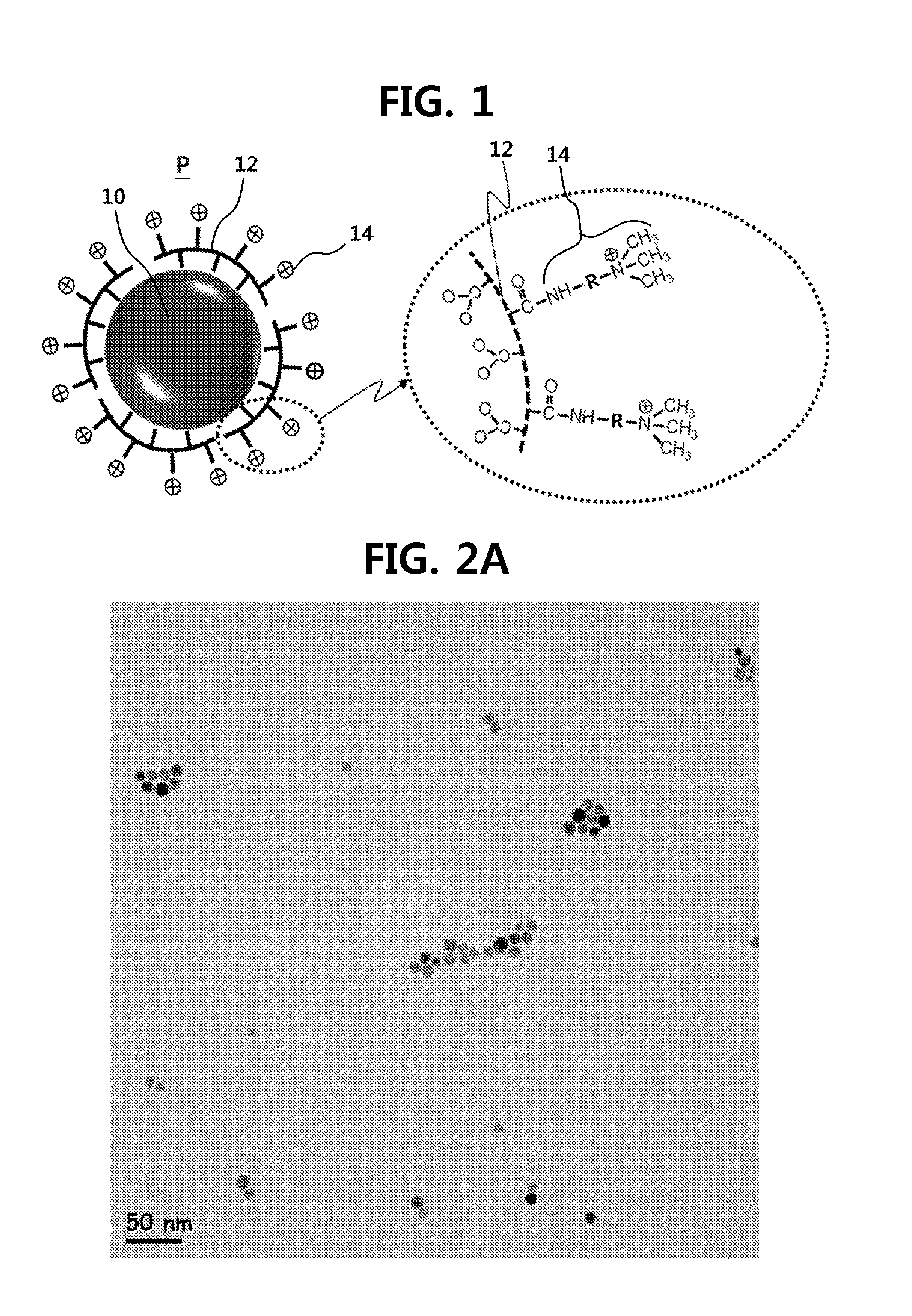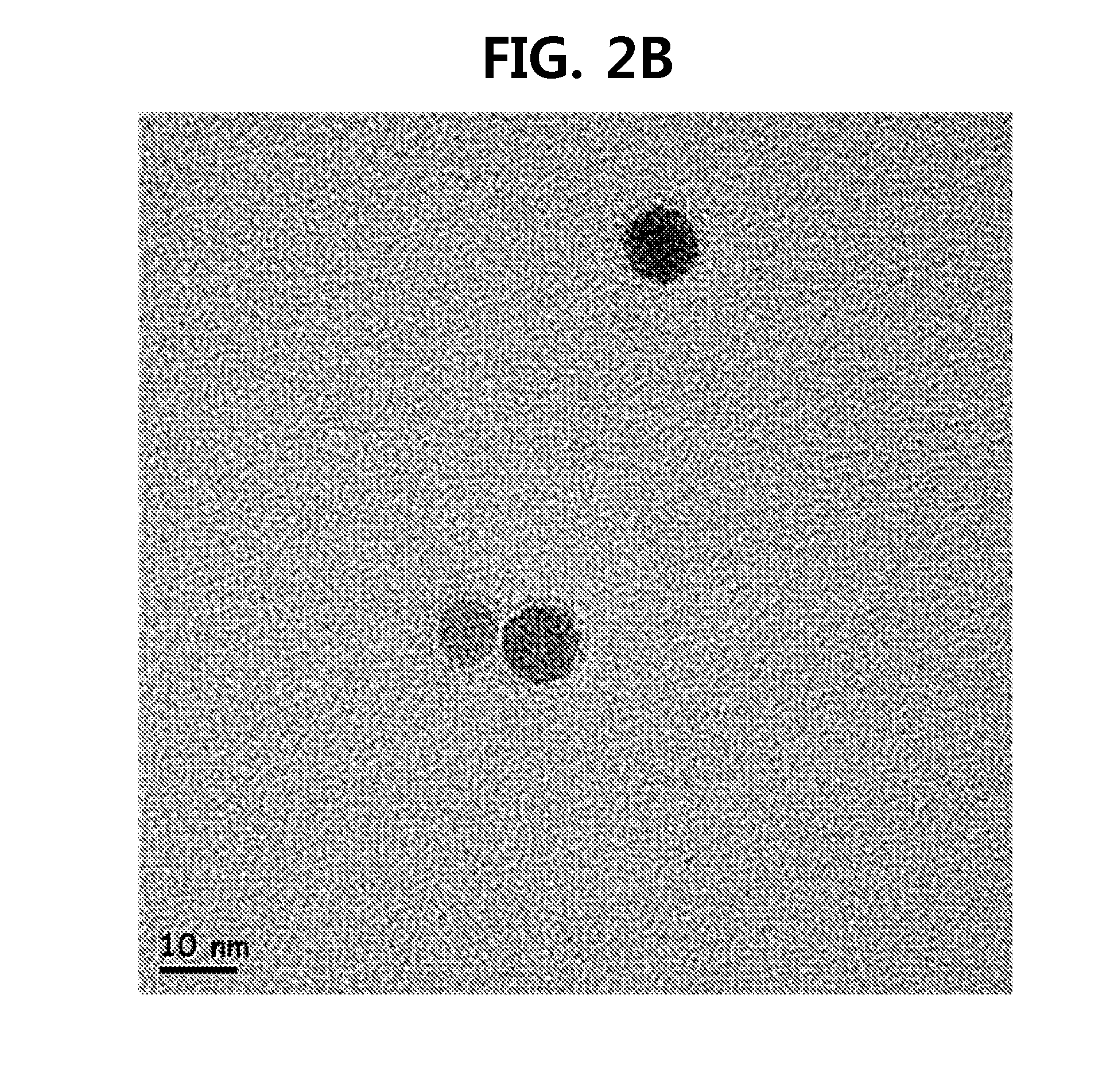Positively-charged superparamagnetic iron oxide nanoparticle, contrast agent using the same and method of preparing the same
a superparamagnetic iron oxide and nanoparticle technology, applied in the field of paramagnetic nanoparticles, can solve the problems of negative effect on cells and tedious task
- Summary
- Abstract
- Description
- Claims
- Application Information
AI Technical Summary
Problems solved by technology
Method used
Image
Examples
preparation example 1
Preparation of SPIONs Whose Surface is Modified With Positive Charge
[0045]Preparation of SPIONs Coated With Hydrophilic Polymer
[0046]The oleic acid-coated superparamagnetic iron oxide (Fe3O4) nanoparticle (OA-SPION) was synthesized according to the procedure of Park et al [Nature materials, 3:891-895 (2004)]. A surface of OA-SPION had a hydrophobic surface characteristic. Subsequently, the oleic acid was substituted with a hydrophilic polymer, polyacrylic acid (PAA), by the following method.
[0047]First, 200 mg of oleic acid-coated SPIONs (OA-SPION) was added to 2 ml of toluene and stirred for one day at 25° C. to be well dispersed. 16 ml of diethylene glycol (DEG) and 2 g of PAA (Mw 1,800, Sigma-Aldrich) were added to a round-bottom flask with a neck, stirred for 5 minutes under an argon (Ar) gas flow, and heated at 110° C. for 30 minutes to completely dissolve PAA in DEG. 2 ml of the toluene solution in which the OA-SPIONs were dispersed was injected into the flask using a syringe...
example 1
Analysis Example 1
Analyses of Shapes, Potentials, and Stabilites of PAA-SPIONs and TMA-SPIONs
[0050]An aqueous solution in which PAA-SPIONs and TMA-SPIONs were dispersed in deionized distilled water was dispensed in a 400-mesh copper grid (Ultrathin carbon film, product No. 01824, TED PELLA, Inc.), dried for one day, and then observed with a TEM (300 kV, FEI Tecnai: F3OST). The SPION was formed in a circular shape, which was not changed before and after the substitution with PAA or TMA. FIGS. 2A and 2B are TEM images of TMA-SPIONs. It was seen that the core of the SPION has a size of approximately 9.6 nm, and a uniform circular shape.
[0051]After a nanoparticle powder was diluted in deionized distilled water, the hydrodynamic size and surface zeta potential of each SPION were analyzed using a particle size analyzer (Nano Zetasizer; Malvern Instruments, Malvern, UK). The average size of the TMA-SPION was approximately 101 nm, which was similar to Feridex (Advanced Magnetics, Inc.) in ...
example 2
Analysis Example 2
Analysis of Relaxivity
[0053]After Feridex (Advanced Magnetics, Inc.) and TMA-SPIONs were respectively dispersed in deionized distilled water, an iron concentration in each dispersed solution was measured by inductively coupled plasma-atomic emission spectroscopy (ICP-AES). As a result, Feridex was detected at 11 mg Fe / ml and the TMA-SPIONs were detected at 2.3 mg Fe / ml. After the solution was diluted with distilled water to prepare solutions with various concentrations, a 1 / T2 per concentration was measured using a 7-Tesla MRI (Bruker Biospin MRI, Germany) and a relaxivity (r2) was obtained from the graph of the 1 / T2 versus concentration. Compared with the r2 indicating an MR image contrasting ability of the SPION, the TMA-SPION has a 4.4 times higher value than Feridex (see FIG. 5). From the T2-weighted image (concentration of the solution=0.698 μg Fe / ml, TR=2500 msec, TE=8.5 msec) obtained by 7-Telsa MRI, it was confirmed that the TMA-SPIONs had a shorter T2 tha...
PUM
| Property | Measurement | Unit |
|---|---|---|
| surface zeta potential | aaaaa | aaaaa |
| diameter | aaaaa | aaaaa |
| zeta potential | aaaaa | aaaaa |
Abstract
Description
Claims
Application Information
 Login to View More
Login to View More - R&D
- Intellectual Property
- Life Sciences
- Materials
- Tech Scout
- Unparalleled Data Quality
- Higher Quality Content
- 60% Fewer Hallucinations
Browse by: Latest US Patents, China's latest patents, Technical Efficacy Thesaurus, Application Domain, Technology Topic, Popular Technical Reports.
© 2025 PatSnap. All rights reserved.Legal|Privacy policy|Modern Slavery Act Transparency Statement|Sitemap|About US| Contact US: help@patsnap.com



